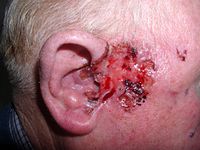
Photo from wikipedia
Traditional histological stains, such as hematoxylin-eosin (HE), special stains, and immunofluorescence (IF), have defined myriads of cellular phenotypes and tissue structures in a separate stained section. However, the precise connection… Click to show full abstract
Traditional histological stains, such as hematoxylin-eosin (HE), special stains, and immunofluorescence (IF), have defined myriads of cellular phenotypes and tissue structures in a separate stained section. However, the precise connection of information conveyed by the various stains in the same section, which may be important for diagnosis, is absent. Here, we present a new staining modality—Flow chamber stain, which complies with the current staining workflow but possesses newly additional features non-seen in conventional stains, allowing for (1) quickly switching staining modes between destain and restain for multiplex staining in one single section from routinely histological preparation, (2) real-time inspecting and digitally capturing each specific stained phenotype, and (3) efficiently synthesizing graphs containing the tissue multiple-stained components at site-specific regions. Comparisons of its stains with those by the conventional staining fashions using the microscopic images of mouse tissues (lung, heart, liver, kidney, esophagus, and brain), involving stains of HE, Periodic acid–Schiff, Sirius red, and IF for Human IgG, and mouse CD45, hemoglobin, and CD31, showed no major discordance. Repetitive experiments testing on targeted areas of stained sections confirmed the method is reliable with accuracy and high reproducibility. Using the technique, the targets of IF were easily localized and seen structurally in HE- or special-stained sections, and the unknown or suspected components or structures in HE-stained sections were further determined in histological special stains or IF. By the technique, staining processing was videoed and made a backup for off-site pathologists, which facilitates tele-consultation or -education in current digital pathology. Mistakes, which might occur during the staining process, can be immediately found and amended accordingly. With the technique, a single section can provide much more information than the traditional stained counterpart. The staining mode bears great potential to become a common supplementary tool for traditional histopathology.
Journal Title: PLOS ONE
Year Published: 2023
Link to full text (if available)
Share on Social Media: Sign Up to like & get
recommendations!